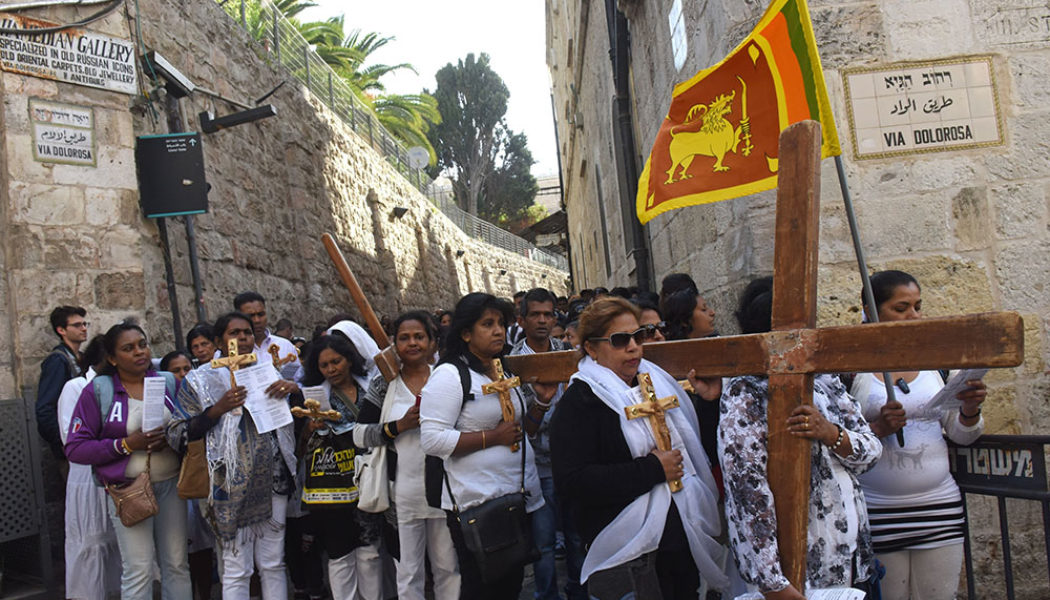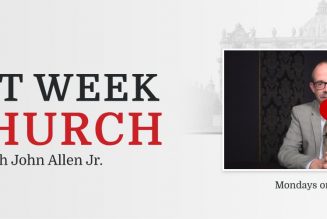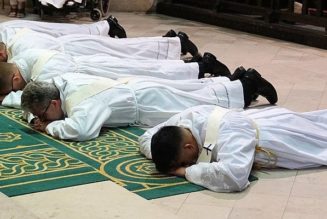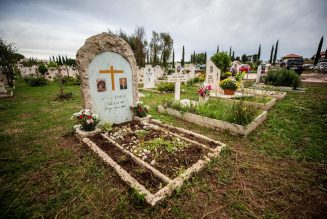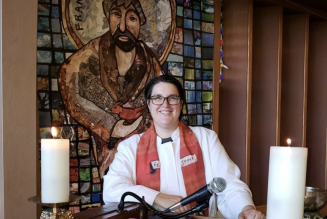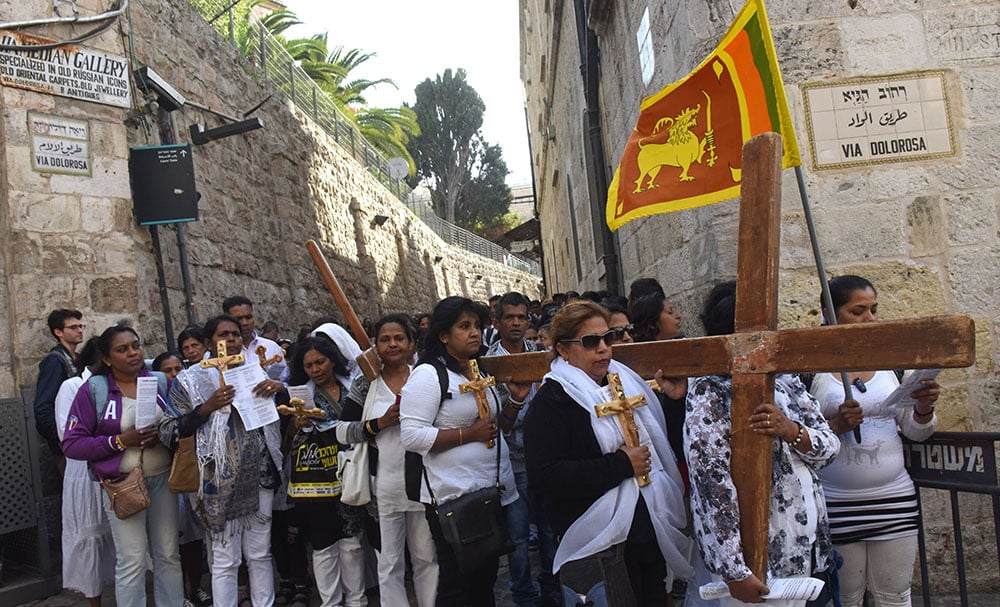
People are pictured during a procession on the Via Dolorosa, “The Way of Sorrow,” the path believed to be taken by Jesus to his crucifixion, in Jerusalem’s Old City in 2017. CNS photo/Debbie Hill
Jesus suffered and died 2,000 years ago, but Catholics today can still attend a reenactment of his funeral and burial — in the Holy Land.
“The funeral procession of Jesus Christ is a unique liturgical procession that only takes place at the Church of the Holy Sepulchre in Jerusalem on Good Friday,” Dominican Father Jordan Schmidt told Our Sunday Visitor. “It is perhaps the most dramatic liturgical event that I have ever witnessed.”
The ancient custom of reenacting Christ’s funeral dates back to the 13th century, when the Franciscans first arrived in the Holy Land, according to the Terra Sancta Museum, which promotes the history of Christianity in the Holy Land by displaying archaeological and art collections of the Franciscans there.
Father Schmidt, an assistant professor of sacred Scripture and the director of Pastoral Field Education at the Dominican House of Studies in Washington, D.C., attended the procession led by the Franciscan friars of the Holy Land last year. It takes place in the church that, according to tradition, houses Christ’s tomb and the site of his crucifixion.
In other words, it happens where it happened 2,000 years ago.
“It is a unique liturgy that does not take place anywhere else in the world and gives worshippers the opportunity to reverence the very place where Jesus Christ suffered, died and was raised,” Father Schmidt said of why Catholics should consider attending. “As such, it is an opportunity for a special experience of God’s grace in the midst of the [Easter] Triduum.”
A profound liturgy
The funeral procession, which includes prayer, Gospel readings and hymns, moves through the church toward Calvary, with a giant, ornate crucifix carried at the front. Once they arrive, two deacons solemnly remove the crown of thorns from the crucifix as well as the nails piercing Christ’s hands and feet. His corpse is lowered from the cross and carried in a white cloth to the Stone of Unction (or Anointing), where his body is anointed with perfumes and incense. Afterward, his body is laid inside Christ’s tomb, where it rests until Holy Saturday.
Father Schmidt described the funeral procession as a bit like the Stations of the Cross but with lengthier readings and chants. The procession includes different “stops,” he confirmed, including at the rock at Golgotha, where Christi’s cross was placed, and Christ’s tomb.
He pointed to one moment in particular as the reason why he recognizes the procession as the most dramatic liturgical event he has witnessed.
“I say this because of the way the funeral of Christ was reenacted: the Franciscan friars pulled out the nails from the hands and feet of the corpus on the cross, anointed the corpus, and then wrapped it in a linen shroud,” he stressed.
After Christ’s corpse is lowered, he remembered that “the patriarch incensed it and gave a beautiful homily about the death of Christ and the importance of the Jerusalem Church’s witness to his death.”
One other thing stood out to Father Schmidt during the 2022 procession: a special Christian unity.
“It was a remarkable experience of the universality of the Church since there were so many speaking different languages and belonging to different rites,” he recalled.
“Also, this is a striking example of Christian unity because the part of the procession that takes place at the top of the Rock of Golgotha requires the permission of the Greek Orthodox Church, who are in charge of the chapel where it is housed,” Father Schmidt said. “They give this permission each year, and this is the only time of the year when they allow Catholics to conduct a service there.”
For those who are unable to attend in person, the Christian Media Center, a communication tool of the Franciscan Custody of the Holy Land, regularly shares a livestream of the event on its YouTube channel.
Following the procession
The annual funeral procession of Christ begins on the evening of Good Friday in the Franciscan Chapel of the Blessed Sacrament, which is located inside the Church of the Holy Sepulchre. As the faithful begin their walk around the church, the Franciscans sing Psalm 51: “Miserere mei, Deus” or “Have mercy on me, O God.”
The leaders of the procession reverently carry a giant crucifix — Christ hanging on the cross — ahead of them.
Every detail holds significance: Even the black-velvet vestments with gold and silver embroidery were created for the church in Valencia in the 19th century, according to the Terra Sancta Museum.
“Particular care is taken on this day in the choice of vestments in order to express the deep reverence and gratitude of the faithful to the Creator for the sacrifice of his Son,” the museum explains.
Between the music, prayer and chants, the procession stops at different locations for readings of the Gospel. One of these stops is considered the site of Christ’s crucifixion. Here, a deacon slowly lifts the crown of thorns off of the crucifix leading the procession. He and another deacon then pull out the nails piercing Christ’s hands and feet. The room is silent except for the sound of a hammer pounding the wooden cross three times before each nail is removed.
With the nails no longer there, Christ’s articulated arms swing down toward the earth.
The deacons place the crown and nails on plates donated by Charles II of Spain, according to the museum. Then, no longer attached to the cross, Christ’s body is gently lowered onto the altar and carried in a white cloth to the Stone of Unction, or the location where Christ’s body is said to have been prepared for burial.
Here, the Custos of the Holy Land, the head of the Custodial Curia that represents the Franciscan Custody of the Holy Land, kneels and anoints the body removed from the crucifix in a symbolic representation of Joseph of Arimathea and Nicodemus, the museum describes.
The custos pours perfume on the body using a container of silver filigree, the museum said, before sprinkling incense from two silver pokals, or goblets, that came from Emperor Leopold I of Habsburg and Mikołaj Zebrzydowski, the voïvode (leader) of Krakow, from the 17th century.
Finally, Christ’s body is placed inside Christ’s tomb in the Church of the Holy Sepulchre, the museum details. He stays there until the next morning, on Holy Saturday — “for the proclamation in the Holy Sepulcher of the Lord’s resurrection and the victory of life over death.”
Katie Yoder is a contributing editor for Our Sunday Visitor.
